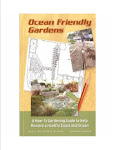Composting
What Can be Composted
The following comes from Surfrider Foundation’s Ocean Friendly Gardens book, Chapter 13:
“Aquarium Water: Straight from the fish tank to the garden, aquarium water is high in nitrogen and phosphorus.
Bone Meal: High in phosphorus, bone meal supports flower production, and helps deter some pests, such as ants. Clean the bones from steak or fish, dry them in a microwave, crush them with a mallet in a bag, and then spread and scratch the powder into the soil.
Catch /
Coffee Grounds: This abundant and often-discarded resource is a good source of nitrogen and can be used as light mulch. When added to compost piles, coffee grounds also help produce nitrogen-rich humus. If asked, local coffee houses will typically give a customer their used grounds.
Compost: Along with the debris produced from a landscape, an actively working compost pile can absorb a variety of oddities, such as hair and dry dog food.
Eggshells: Containing a large amount of calcium and moderate amount of nitrogen, eggshells can either be scattered directly over a landscape, or put in a compost pile.
Feathers: While not an abundant resource unless there is a bird in a house, or the property has a cat, feathers are an excellent source of nitrogen. This resource should be composted.
Grass Clippings: The debris created from mowing a lawn is a perfect high-nitrogen fertilizer if it is cured in a compost pile first. Scattering freshly cut grass over soil does not work as well, because if it is not kept moist then the sun will chemically break them down and they will be blown off the property; on the other hand, if the clippings are kept too moist, they may produce an acidic barrier on top of the soil.
Hair: Human and pet hair is rich in iron, manganese, and sulphur. Hair is best used as an additive in a compost pile, but when used as mulch it can help deter larger pests, such as some rodents and birds.
Kitchen Scraps: Kitchen scraps of vegetables and fruits make some of the richest composts. Kitchen scraps are fleshy, moist, and loaded with nutrients, which speeds the decomposition process and time required to turn the scraps into compost and humus. Tea bags, coffee grounds, crushed and dry dog food, and eggshells can be thrown into this mix. These high-activity compost piles do not require a lot of room, just an area comparable to an old bathtub; yet they provide an excellent source of readily available nutrients. Kitchen scraps are typically high in phosphorus and potassium, but low in nitrogen (unlike animal products).
Pine Needles: An abundant resource in many landscapes, pine needles belong in a compost pile, or used as a mulch to deter weeds. Needles are low in nitrogen, phosphorus and potassium.
Tea Grounds: An abundant resource in many homes and coffee houses. Tea grounds have a moderate amount of nitrogen and low amounts of phosphorus and potassium. This resource should be composted.
Wood Ashes: Completely cooled and dispersed straight from the fireplace to the garden beds, wood ashes are high in potassium, with minor amounts of phosphorus, which is perfect for flowering and fruiting plants. Ashes are a good addition to the compost pile.”
Composting Workshops
City of
http://www.ci.la.ca.us/san/solid_resources/recycling/composting/index.htm
Compost Bins
Those sold by the City of
http://www.ci.la.ca.us/san/solid_resources/recycling/composting/bins.htm
A broad variety
http://www.composters.com/compost-bins.php?gclid=CLSymq65ipoCFRMUagodSTdbFg
Earth Maker
http://www.earthmaker.co.nz/cms/index.php?page=user-guide
Spinning Composter
http://www.gaiam.com/product/eco-home-outdoor/outdoor/composting/spinning+composter.do
Tumble Weed Compost Tumbler
http://www.compostguide.com/Tumbleweed-Compost-Tumbler-Bin-p/200003.htm
Compost Tea
From OFG book, Chapter 13: “Compost Tea: An organic concoction that concentrates nutrients in a liquid form. Useful in overcoming degraded areas and supporting productive landscapes. Tea is made by filling a permeable bag, like nylon stocking or burlap bag, with compost (generally made from worm castings, manures, and/or grass clippings) and setting the bag in a large bucket of water. The tea takes frequent stirring, or mechanical aeration, and about 2 days of seeping.” Click here to learn more about compost tea makers from the company, Keep It Simple. Another company, Malibu Compost, is selling both biodynamic compost in bags as well as biodynamic compost tea bags at many nurseries - and find out if one near you is.
Grow a Green Manure Crop
From the OFG book, Chapter 6: “Sow Green Manure: There are a variety of plants that are particularly good at improving degraded soils, called green manures. These plants include those that can fixate nitrogen, like clover and vetch, and those that are tough and vigorous, such as alfalfa, millet and rye. These plants are seeded and once they have a hold of landscape they are tilled into the soil and allowed to decompose. The area will be ready for planting 3 months after tilling.”



0 comments:
Post a Comment